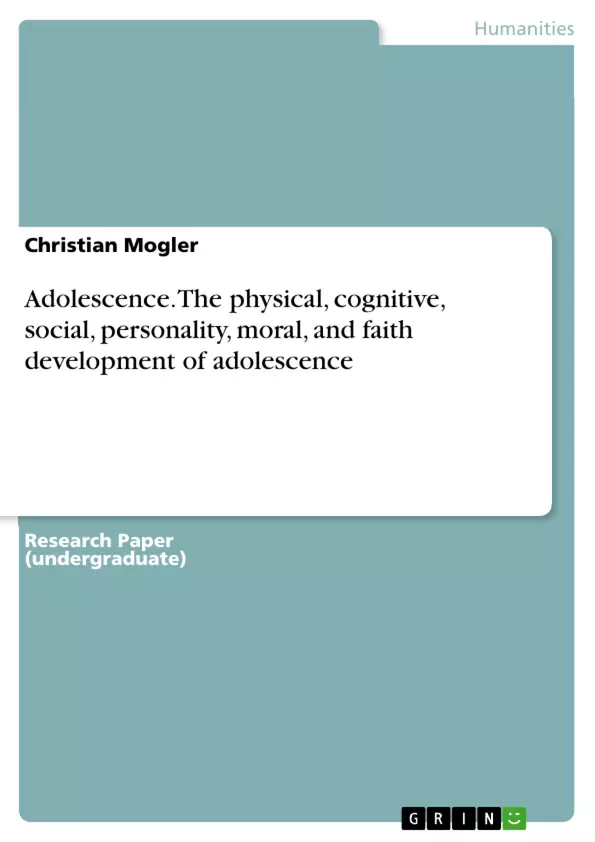Life is marked by developmental changes in every domain of life: physical, cognitive, social, personality, faith, and moral. Due to great researchers such as Erikson, Kohlberg, Freud, Piaget, and Fowler we are able to understand the development of each domain more thoroughly and are consequently almost able to predict the development from a baby to an adult with accuracy. Each stage of life has its own challenges and key events which have a huge impact on a person´s life, challenges which can be dealt with successfully or not-successfully. The aim of this paper is to overview the life stage “adolescence, the last stage of childhood ” with its incorporated challenges, events and characteristics in the domains of a person’s physical, cognitive, social, personality, faith, and moral life. (For a general overview and comparison over the major theories of human cognitive, physical, social, moral, and faith development please find the charts in Appendix I.)
Table of Contents
- Physical
- Issues
- Cognitive
- Issue
- Personality
- Social
- Morality
- Faith
- Issues
- Conclusion
Objectives and Key Themes
The objective of this paper is to provide an overview of adolescence (ages 13-20), examining its challenges, events, and characteristics across various developmental domains: physical, cognitive, social, personality, faith, and moral development. The paper utilizes established theories from researchers such as Erikson, Kohlberg, Freud, Piaget, and Fowler to understand these developmental aspects.
- Physical Development in Adolescence
- The Impact of Developmental Asynchrony
- Social and Emotional Challenges of Adolescence
- The Role of Identity Formation
- Spiritual and Moral Development during Adolescence
Chapter Summaries
Physical: The chapter details the significant physical changes occurring during adolescence, including the growth spurt, maturation of the reproductive system (puberty), and the development of primary and secondary sex characteristics. It highlights the variations in the timing of puberty and its impact on an adolescent's self-image. The discussion includes the potential for emotional distress stemming from discrepancies between chronological age and physical maturity, and the societal pressures related to body image.
Issues: This section explores the challenges associated with the physical changes of adolescence. It focuses on the potential for feelings of awkwardness, embarrassment (due to pimples, body odor, etc.), and low self-esteem, particularly for those whose physical development doesn't align with societal ideals. The chapter emphasizes the importance of supportive relationships in navigating these challenges and developing a healthy sense of self.
Keywords
Adolescence, physical development, cognitive development, social development, personality development, moral development, faith development, puberty, identity formation, developmental asynchrony, body image, self-esteem.
Frequently Asked Questions: Adolescent Development Overview
What is the purpose of this document?
This document provides a comprehensive preview of a paper focusing on adolescent development (ages 13-20). It includes a table of contents, objectives, key themes, chapter summaries, and keywords. The paper examines the challenges, events, and characteristics of adolescence across various developmental domains.
What developmental domains are covered?
The paper explores physical, cognitive, social, personality, faith, and moral development during adolescence. Established theories from researchers such as Erikson, Kohlberg, Freud, Piaget, and Fowler are utilized to understand these aspects.
What are the key themes explored in the paper?
Key themes include physical development in adolescence, the impact of developmental asynchrony (discrepancies in the timing of physical and emotional maturation), social and emotional challenges of adolescence, the role of identity formation, and spiritual and moral development during adolescence.
What does the chapter on physical development cover?
The physical development chapter details significant physical changes during adolescence, including the growth spurt, puberty, and the development of primary and secondary sex characteristics. It also addresses variations in puberty timing, its impact on self-image, and societal pressures related to body image.
What issues related to physical development are discussed?
The "Issues" section explores challenges associated with physical changes, such as feelings of awkwardness, embarrassment (due to pimples, body odor, etc.), and low self-esteem, particularly for those whose development doesn't align with societal ideals. The importance of supportive relationships in navigating these challenges is highlighted.
What are the keywords associated with this paper?
Keywords include: Adolescence, physical development, cognitive development, social development, personality development, moral development, faith development, puberty, identity formation, developmental asynchrony, body image, self-esteem.
What is the structure of the Table of Contents?
The Table of Contents includes sections on Physical Development (with a sub-section on Issues), Cognitive Development (with a sub-section on Issues), Personality Development, Social Development, Morality, Faith, and a Conclusion.
- Arbeit zitieren
- Christian Mogler (Autor:in), 2008, Adolescence. The physical, cognitive, social, personality, moral, and faith development of adolescence, München, GRIN Verlag, https://www.grin.com/document/123676



